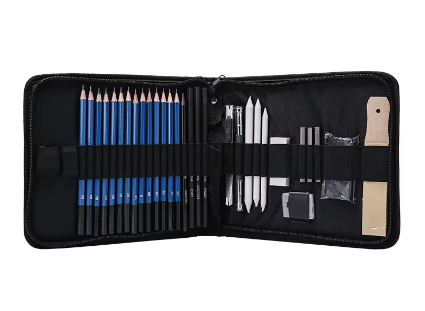Understanding Pencil Grades and Their Impact on Your Art
H vs. B: Decoding Graphite Hardness Scales
The grade of pencil used makes a real difference in how artwork turns out since different pencils offer various levels of hardness and darkness. On the graphite hardness scale we go from H for hard pencils all the way to B for the soft ones. Hard pencils like the H grades contain more clay mixed with less graphite, so they work great when someone needs to draw fine lines or do detailed stuff without worrying about things getting smudged too easily. Soft B pencils on the other hand pack more graphite into their lead formula, letting artists create darker marks that really stand out. These are fantastic choices for shading techniques and making artwork look more dramatic and impactful overall.
The HB pencil sits right between H and B grades, combining features from both ends of the spectrum. Artists find this middle ground really useful because it works across so many different situations. The graphite in HB pencils strikes just the right balance, making them great for people just starting out as well as seasoned professionals. These pencils create lines that aren't too dark or too light, which means they handle everything from rough sketches to more intricate drawings without missing a beat. Knowing how each pencil type behaves helps artists pick the right tool for whatever effect they want to achieve on paper.
Why Middle Grades Like HB and 2B Are Versatile Starters
Artists tend to reach for middle grade pencils like HB and 2B because they work so well across different situations. Take the HB pencil for instance it sits right in the middle between hard and soft, which is why many folks find it great for all sorts of stuff. Some days they're sketching delicate outlines, other times filling in larger areas. That kind of flexibility explains why HBs end up in almost every artist's bag. No need to constantly swap out pencils when going back and forth between notes and actual artwork. Pretty handy really.
The 2B pencil gets a lot of love from artists because it creates those rich dark lines without making the hand too shaky during detailed work. Artists find them especially handy when working on drawings or sketches where they need those deep shadows to make portraits pop or give landscapes some real depth. Both beginners trying out their first sketchbook pages and professionals working on commissions appreciate how these pencils respond well to different pressures and styles. Many drawers full of art supplies will have several 2B pencils sitting alongside other grades, since they strike such a good balance between darkness and control that makes them perfect for everything from quick studies to finished pieces.
Comparing Core Types: Graphite vs. Colored vs. Specialty Pencils
Graphite for Sketching: Precision and Shading Flexibility
Graphite pencils really stand out when it comes to getting precise sketches done, something most artists need when working on detailed drawings. There's quite a range of graphite grades available too, going from the hard H series all the way down to the soft B grades. This variety gives sketch artists plenty of options depending on what they want to achieve. Harder pencils work great for those super fine lines and tiny details that pop up in technical drawings. Soft ones though? Those babies are fantastic for building up shadows and adding texture to surfaces. Take Staedtler and Faber Castell for example. Both have been around forever and their pencils just keep performing reliably even after years of use. Many artists swear by them because they don't break easily and maintain their point much better than cheaper alternatives.
Oil vs. Wax-Based Colored Pencils: Budget Considerations
The decision between oil based versus wax based colored pencils really comes down to what matters most in art supplies these days. Wax based ones, think Prismacolor Premier for example, tend to be cheaper upfront while still delivering bright colors that blend nicely on paper. Artists who watch their spending often gravitate toward these because they work well enough for most projects. The downside? They snap pretty easily if not handled carefully. Oil based pencils like Faber Castell Polychromos come at a steeper price tag but deliver something special when it comes to color intensity. These just look better on canvas and don't break nearly as often during regular use. Budget becomes a big factor here though. Most wax pencils sit somewhere around ten to thirty bucks depending on brand quality, while good oil based sets typically begin around thirty dollars and climb from there based on how many colors someone wants.
Budget Factors Every Artist Should Evaluate
Price vs. Quality: Finding the Sweet Spot
Picking out drawing pencils means thinking about what they cost versus how good they actually are. Usually, pricier pencils tend to work better and last longer, but there are definitely some great options that won't break the bank. Found a few brands lately that deliver solid performance without charging an arm and a leg. Take Faber Castell for example they make really nice pencils that most artists love, and Prismacolor stuff works pretty well too when budget is a concern. Before spending a bunch of money on a whole set, testing them out first makes sense. Grabbing a small pack or just a couple individual pencils to try them on paper is probably the smartest move. That way anyone can see if they feel right in hand and produce the marks they want.
Student-Grade vs. Professional Sets: When to Upgrade
Knowing the difference between student grade and pro sets matters a lot for artists at different stages. Student kits usually come with basic stuff good enough for folks just starting out, while professional sets pack better materials and actually work better for serious art making. When thinking about upgrading, look at what happens with other artists who made the switch to pro gear and saw real differences in their finished pieces. Most artists find that spending money on proper pencils makes sense once they start working on intricate details or bigger commissions where quality really shows through. The best approach? Take stock of where skills currently stand and what kind of projects are on the horizon before deciding whether to spend extra cash on those premium sets.
Long-Term Value: Investing in Durable Pencils
Spending money on good quality drawing pencils might actually save artists cash in the long run. Sure, budget options work fine when someone just needs something temporary, but those fancy pencils tend to last way longer before needing replacing. Many veteran artists swear by certain brands that stand the test of time, Caran d'Ache being one name that comes up again and again in conversations about value for money. Want to get the most out of these investments? Store them properly away from moisture and avoid pressing too hard while sketching. Over time, this kind of care makes all the difference. Artists who prioritize decent materials usually end up producing better work anyway, which speaks volumes about the connection between tool quality and creative output.
How to Test Pencil Quality Without Breaking the Bank
Assessing Lead Consistency and Break Resistance
Testing how well a drawing pencil holds up when pressed hard against paper gives a good idea about its quality without spending too much cash. Try this quick test: grab some scrap paper from around the studio and start shading with different amounts of pressure. Good pencils should leave smooth, uniform marks without snapping inside, even when pushed pretty hard. Most artists already have everything needed for this right there in their workspace – just some old sketch sheets and maybe an eraser lying around somewhere. Draw short lines here and there, then press down harder between each one to see if anything breaks or looks uneven. Brands like Prismacolor and Staedtler stand out because they tend to hold up really well during these little experiments. They're worth considering for anyone who wants decent pencils without emptying their wallet completely.
Paper Compatibility: Smooth vs. Textured Surfaces
Trying out how pencils perform on various kinds of paper is pretty much a must if anyone wants to know what works together and what doesn't. Paper texture really affects how colors look when applied. Smooth sheets generally pair well with softer pencils, giving that nice clean line without skips or breaks. Textured stuff actually makes harder leads stand out more, adding dimension to drawings. Most artists notice big differences between something like Bristol board (super smooth) versus watercolor paper which has those little bumps and ridges. Each type interacts differently depending on pencil hardness too. Brands like Strathmore make decent papers at reasonable prices so folks don't have to spend a fortune experimenting. After doing some testing sessions, most creatives figure out which combinations give them the best results for their particular style and materials.
Tailoring Your Choice to Skill Level and Project Needs
Beginners: Starter Kits with Essential Grades
Newcomers getting started with drawing will find starter kits packed with basic pencil grades really helpful. Most good kits come with everything from super soft 2B pencils all the way up to harder HB ones. Having this range lets people try out different effects when they're learning how to draw. Many artists who've been around a while swear by starting with multiple pencil types because it teaches folks about shadows and lines in a hands-on way. Someone posted online about their own experience saying something like, "I bought one of those beginner packs and figured out which pencils worked best for me without spending a fortune first." Companies such as Faber Castell and Derwent make some solid starter sets that include pretty much every pencil grade someone might need while they're still figuring things out.
Advanced Artists: Curating Custom Sets for Specific Techniques
Serious artists usually pick out their pencils based on what they need for each project and technique, building custom collections that match their particular style requirements. When working on shading effects, delicate lines, or smooth blends, getting the right pencils really makes a difference in how creative someone can get. Artists who want those gradual color shifts tend to reach for softer grades like B or 2B pencils, whereas the harder H and 2H types work best when doing intricate detailing. Companies such as Prismacolor have developed great products specifically for different tasks, including their popular oil-based sticks that blend beautifully. Caran d'Ache also offers premium options with unique properties that many professionals swear by. Putting together personalized sets means artists can experiment more freely and discover new ways to express themselves through their work.
FAQ
What are the differences between H and B pencils?
H pencils are harder and contain more clay, making them suitable for fine lines with minimal smudging. B pencils are softer, contain more graphite, and are ideal for darker, richer marks.
Why are HB and 2B pencils recommended for artists?
HB and 2B pencils are versatile and can be used for different tasks, from writing to sketching. HB provides a balanced blend of hardness and softness, while 2B offers darker lines with easy control.
Should I choose oil-based or wax-based colored pencils?
Oil-based pencils provide rich, vivid colors and are more durable, while wax-based pencils are more affordable and offer vibrant colors but may break easily.
How can I test pencil quality before purchasing?
Perform simple tests by using varied pressure on scrap paper to assess lead consistency and strength without breaking. This method helps determine pencil durability and quality.
Can beginners start with professional-grade pencils?
Beginners should start with starter kits that offer a variety of grades, allowing them to explore different techniques before investing in professional-grade pencils.


